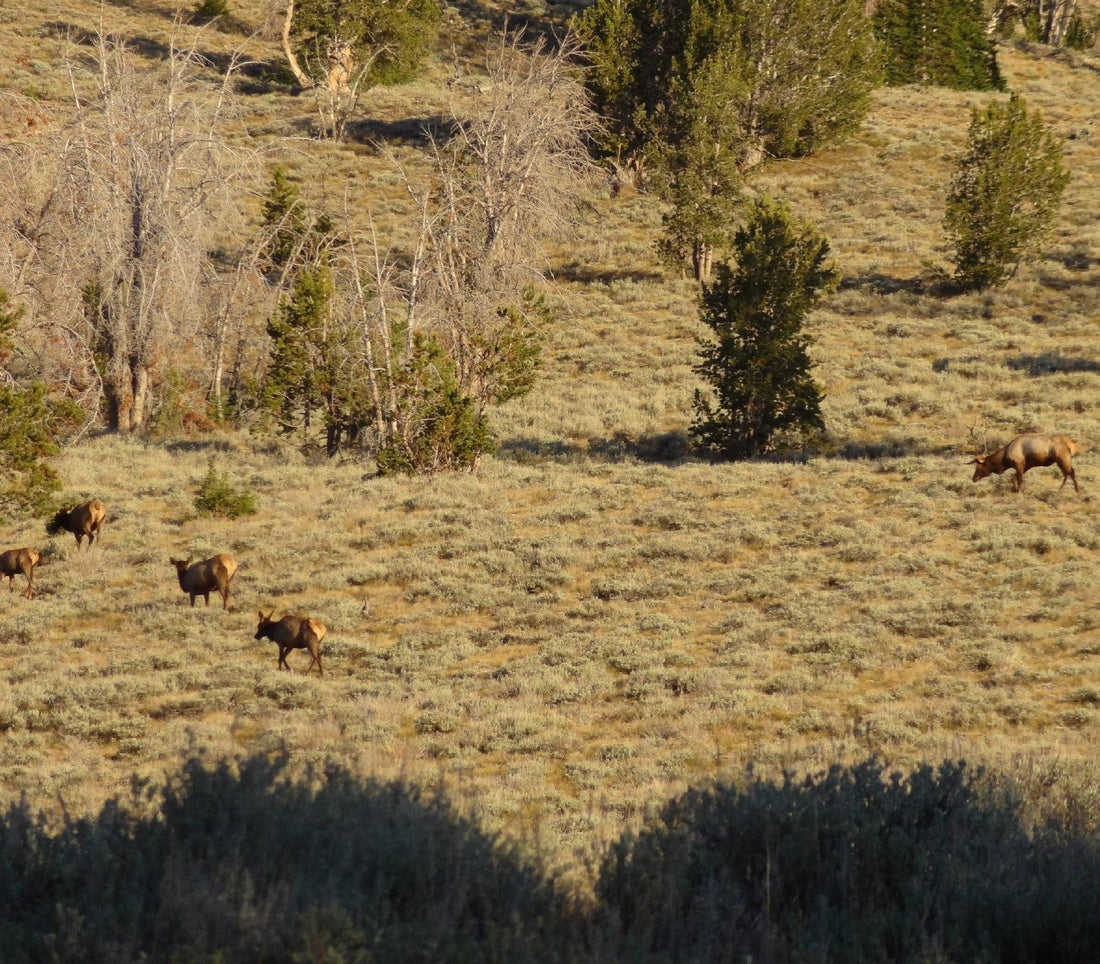
Early Summer Elk Scouting
Zach BowhayAre you planning an archery elk hunt? The time to scout is now!
If you asked ten different successful elk hunters, you'd probably get ten different answers. But in my opinion, the best time to scout for archery elk is right now, June through early July. That window can shift by a week or two depending on the previous winter’s snowpack, but generally, the best time to scout for September is as soon as you can get into the mountains and start moving through elk country after most of the snow has melted.
Alright, that’s all you need to know. The article is over. Get out there and start scouting… Just kidding.
Instead of asking you to take my word for it, let me explain why I believe this time of year is ideal.
Elk Are in Their Summer Patterns
Currently, elk are settling into their summer routines. Cows are wrapping up calving, and bulls are hanging out in bachelor groups. For the most part, their focus is simple: feed on the lush spring and early summer vegetation.

During this period, cows and calves tend to stick to more accessible country—think lush meadows and gentler terrain. Bulls, on the other hand, often retreat to higher, more secluded areas that still offer good feed. These summer ranges may be close to where they’ll be come September, but their current routines are very much centered around food and recovery.
Of course, this is a generalization; not every elk follows the script, but it should give you a general idea of what they’re doing and where to find them this time of year.
Why Does All This Matter?
I believe it matters—for good reason.
As the rut approaches, bulls begin to shift their behavior. They’ll leave their summer hideouts and start moving toward the cows. That makes this the perfect time to scout the areas where cows are currently spending their time.
These cow-centric zones often overlap with traditional rutting grounds. And if you spend enough time in these spots now, you’ll start to notice the signs: old rubs on trees, long-established wallows, and even older droppings that tell the story of past Septembers.
Yes, there are exceptions. Sometimes elk rut in new areas, or they appear out of nowhere in a country that seemed dead a week before. But in my experience, those are outliers.
After more than 30 years of seriously hunting elk in September, I can say with confidence that elk tend to rut in the same general areas, year after year.
What If I Spook Elk?
Let me be clear—I'm not suggesting you spend all summer bumping elk out of the area you plan to hunt.
Instead, I recommend making a focused effort early in the summer, well before the season opens. If you do spook an elk or two now, they’ll have plenty of time to forget about it and settle back into their routines long before September.
That said, don’t go barging in without a plan.
Start with some e-scouting. Use your favorite mapping app or Google Earth to get a sense of the terrain. If digital scouting isn’t your thing, that’s fine too. I’ve also had great success just showing up and spending a day getting familiar with the area.

Either way, pick out a few promising routes and plan some boots-on-the-ground recon. Hike through areas that look like good fall hunting spots. Look for signs from previous seasons, such as rubs, tracks, droppings, and trails. Mark Waypoints and take notes as you go.
Scouting isn’t just about spotting elk; it's about learning the country, refining your plan, and increasing your odds when the season hits. Yes, it’s nice to spot elk and see bulls, and we will discuss that further in a later article, but finding signs from previous September’s is a critical piece of the puzzle.
Specific Areas of Focus
One of the most accurate sayings about elk hunting is: “Elk are where you find them.” They can be nomadic and unpredictable at times, but once you figure out where elk want to be, patterns begin to emerge. And those patterns can make it a whole lot easier to find elk, no matter where you hunt them.
Start by focusing on proven elk-friendly terrain features, such as high benches on steep mountainsides, dark timber on north-facing slopes, water sources in dry country, and travel corridors like saddles or pinch points between bedding and feeding areas.
Even during the season, elk often feed into large openings in the evenings and spend much of the night out in the open. By early morning, they’re usually on their way back to cover. Watching elk in those open meadows can be fun, but they rarely offer great shot opportunities with a bow. The smarter move is to study where they go once the sun’s up—because that’s where you’ll likely be hunting them.
So, plan your scouting hikes with purpose. Make it a point to hike through that dark timber, cruise those high benches where elk like to bed, swing by secluded saddles, and check out tucked-away water sources. Seeing elk now is great, but knowing where they'll come bow season? That’s gold.
Trail Cameras: A Scouting Bonus
Speaking of hidden gems, if it’s legal in your state, consider bringing along a trail camera or two on your scouting trips. I always try to keep a couple in my pack. They’re lightweight, easy to carry, and come in handy more often than not. It seems like the one time I don’t bring them is the time I find the perfect spot and end up kicking myself for not packing one.
I like to target secluded water sources, game trails that cut through saddles, and pinch points between bedding and feeding areas. These spots tend to see consistent elk traffic throughout the summer and often give you a glimpse into what might be happening come September.


Even if you don’t get a perfect inventory of bulls, trail cams are just plain fun. They give you a reason to make one more trip back before the season starts—and sometimes that last-minute check can provide the final piece of the puzzle.
Disclaimer: Always check your state’s regulations before using trail cameras, especially during or close to hunting season.
Final Thoughts
Scouting for elk in early summer isn’t just about spotting animals; it’s about building a foundation. It’s your chance to learn about the country, identify likely travel patterns, and uncover the subtle details that separate good hunts from great ones. Whether you’re checking out a high bench, sneaking through dark timber, or dropping a trail cam on a remote waterhole, every mile you cover now adds to your confidence come September. So, lace up your boots, make a plan, and get into elk country while it’s still quiet. You might not hear bugles yet, but the work you put in now will echo loud and clear when the season opens.
Zach Bowhay is known as a hunter and writer who has successfully hunted many species all across the western states and beyond. Specifically, he is highly regarded in the western hunting community as an expert in DIY elk hunting on public lands. For 15 years he has been a well-published writer, sharing his love of the outdoors and expertise in both gear and tactics through his writing as well as video and photos. When not spending time with his wife and three kids he can be found roaming the mountains of the west in the pursuit of adventure.
Find him on Instagram
